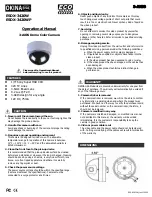
V1.02
Thom Hogan’s Complete Guide to the Nikon D300
Page 408
But conservative photographers also take into account the
amount of magnification that the final image undergoes. An 8
x 10” print from a D300 comes from a smaller imaging area
than a print from a 35mm film negative or D3 sensor, thus
undergoes more magnification. Details that were small
enough to pass as in focus to our eye at normal viewing
distances may appear out of focus when magnified.
I could present a long theoretical discourse and
accompanying math regarding the differences between 35mm
film and the D300, but that’s a bit beyond the scope of this
book. Instead, I’ll present my conclusion: depth of field
appears to me to be a bit less than a one stop difference for a
D300 than 35mm film or the FX sensor on the D3.
So, if you’re using depth of field or hyperfocal distance charts
intended for 35mm film cameras with your D300, simply add
a stop for a conservative approach. For example, if your
35mm film chart says that the hyperfocal distance is 50 feet
for a 50mm lens at f/2 (which it should if it uses the
conservative Zeiss circle of confusion value!), simply use f/2.8
on the D300.
Note: The depth of field markings on most Nikkor lenses appear to
be calculated using a circle of confusion of 0.03, with a few
older ones possibly using 0.033. Carl Zeiss suggested that
the circle of confusion should be 1/1730
th
of the diagonal
measurement of the frame, which for 35mm would be
0.025. That’s the value that I, and many other professionals,
use for 35mm. For a D300, the Zeiss number would be
0.016 (technically 0.016416, but I round down). Since the
penalty for goofing up depth of field is often an
unpublishable image, it pays to use conservative values.
The tables that follow are calculated for the D300 using the
0.016 circle of confusion value, and use distances in feet (if
you want meters, see the software on the
Complete Guide
CD—you can create and print your own tables for meters).
















































